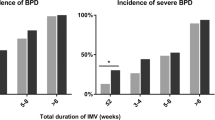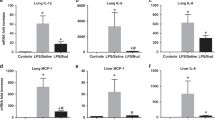Abstract
OBJECTIVES: This study examined the effects of intrauterine cocaine exposure on very low birth weight infants with respect to their surfactant requirement and need for ventilatory support.
STUDY DESIGN: A retrospective cohort study was conducted on infants with birth weight between 750 and 1500 g admitted to the neonatal intensive care unit between January 1992 and January 1995.
RESULTS: Of the 149 infants studied, 48 infants were exposed only to cocaine and 101 infants had no drug exposure. There were no significant differences between the two groups for gestational age, sex, abruptio placenta, prolonged rupture of membranes, and antenatal steroid usage. The cocaine-exposed group had a significantly greater birth weight (1190 vs. 1109, p<0.02), less prenatal care (48% vs. 14%, p<0.00007), older maternal age (30 vs. 24, p<0.00002), more black race (79% vs. 57%, p<0.01), and more rapid plasma reagin (RPR) positivity (25% vs. 2%, p<0.00006). There were no significant differences in median APGAR scores, or incidence of necrotizing enterocolitis, retinopathy of prematurity (ROP), intraventricular hemorrhage (IVH), and bronchopulmonary dysplasia (BPD) between the two groups. Cocaine-exposed infants received surfactant treatment less often (73% vs. 48%, p<0.0035), received fewer mean doses of surfactant (0.4 vs. 10.0, p<0.0014), and were intubated less frequently (44% vs. 65%, p<0.012). There was no significant difference between groups for intubation at 24 and 48 hours and for the development of bronchopulmonary dysplasia.
CONCLUSION: Perinatal cocaine exposure appears to have some significant short-term effects on the need for surfactant replacement therapy and need for initial intubation in respiratory distress syndrome (RDS) but no overall effect on the development of BPD.
This is a preview of subscription content, access via your institution
Access options
Subscribe to this journal
Receive 12 print issues and online access
$259.00 per year
only $21.58 per issue
Buy this article
- Purchase on Springer Link
- Instant access to full article PDF
Prices may be subject to local taxes which are calculated during checkout
Similar content being viewed by others
References
Chasnoff IJ, Burns WJ, Schnoll SH, et al Cocaine use in pregnancy N Engl J Med 1985 313 666–9
Zuckerman DA, Zuckerman BS, Amaro H, et al Cocaine use during pregnancy: prevalence and correlates Pediatrics 1988 82 888–95
MacGregor SN, Keith LG, Chasnoff IJ, et al Cocaine use during pregnancy: adverse perinatal outcome Am J Obstet Gynecol 1987 157 686–90
Moore TR, Sorg J, Miller L, et al Hemodynamic effects of intravenous cocaine on the pregnant ewe and fetus Am J Obstet Gynecol 1986 155 883–8
Woods JR, Plessinger MA, Clark KE Effect of cocaine on uterine blood flow and fetal oxygenation JAMA 1987 257 957–61
Acker D, Sachs BP, Tracey KJ, et al Abruptio placenta associated with cocaine use Am J Obstet Gynecol 1983 146 220
Dusick AM, Covert RF, Schreiber MD, et al Risk of intracranial hemorrhage and other adverse outcomes after cocaine exposure in a cohort of 323 very low birthweight infants J Pediatr 1993 122 438–45
Sehgal S, Ewing C, Waring P, et al Morbidity of low-birthweight infants with intrauterine cocaine exposure J Natl Med Assoc 1993 85 20–4
Beeram MR, Abedin M, Young M, et al Effect of intrauterine cocaine exposure on respiratory distress syndrome in very low birthweight infants J Natl Med Assoc 1994 86 370–2
Hadeed AJ, Siegel SR Maternal cocaine use during pregnancy: effect on the newborn infant Pediatrics 1989 84 205–10
Zuckerman B, Mayanrd EC, Cabral H A preliminary report of prenatal cocaine exposure and respiratory distress syndrome in premature infants AJDC 1991 145 696–8
Maynard EC, Dreyer SA, Oh W Prenatal cocaine exposure and hyaline membrane disease Pediatr Res 1989 25 223A
Liechty EA, Donovan E, Purohit D, et al Reduction of neonatal mortality after multiple doses of bovine surfactant in low birth weight neonates with respiratory distress syndrome Pediatrics 1991 88 19–28
Gluck L, Kulovich MV Lecithin/sphingomyelin ratios in amniotic fluid in normal and abnormal pregnancy Am J Obstet Gynecol 1973 115 539
Yoon JJ, Harper RG Observations on the relationship between duration of rupture of the membranes and the development of respiratory distress syndrome Pediatrics 1973 52 161–8
Yoon JJ, Kohl S, Harper RG The relationship between maternal hypertensive disease of pregnancy and the incidence of idiopathic respiratory distress syndrome Pediatrics 1980 65 735–9
Enhorning G, Chamberlain D, Contreras C, et al Isoxsuprine-induced release of pulmonary surfactant in the rabbit fetus Am J Obstet Gynecol 1977 129 197
Walters DW, Olver RE The role of catecholamines in lung liquid absorption at birth Pediatr Res 1978 12 239
Sosenko TRS Cocaine administration to pregnant rats produces increased surfactant maturation without affecting antioxidant enzyme development Pediatr Res 1991 29 330A
Guy J, Dhanireddy R Effect of cocaine on surfactant synthesis and secretion by alveolar type II cells Pediatr Res 1991 29 60A
Author information
Authors and Affiliations
Additional information
Presented in part at the annual meeting of the Society for Pediatric Research, San Diego, CA, May 7–11, 1995.
Rights and permissions
About this article
Cite this article
Hand, I., Noble, L., McVeigh, T. et al. The Effects of Intrauterine Cocaine Exposure on the Respiratory Status of the Very Low Birth Weight Infant. J Perinatol 21, 372–375 (2001). https://doi.org/10.1038/sj.jp.7210552
Published:
Issue Date:
DOI: https://doi.org/10.1038/sj.jp.7210552



